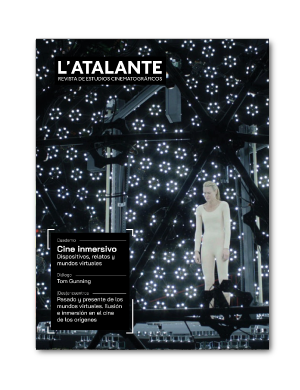Adentrarse virtualmente en un paisaje en la era pre-digital: de los viajes pintorescos del siglo XIX al recorrido inmersivo de 'Los sueños de Akira Kurosawa' (1990)
Publicado 01.01.2023
Palabras clave
- Paisaje,
- Inmersión,
- Virtual,
- Cine,
- Pintura
- Precine,
- Dispositivo de visión,
- Pintoresco ...Más
Cómo citar
Derechos de autor 2023 L'Atalante. Revista de estudios cinematográficos

Esta obra está bajo una licencia internacional Creative Commons Atribución-NoComercial-SinDerivadas 4.0.
Resumen
En el camino hacia la virtualización, múltiples dispositivos de visión han utilizado el motivo del paisaje como herramienta para experimentar con la mirada del observador. Desde las pinturas de paisaje del siglo XVII, pasando por gran parte de los aparatos visuales precinematográficos del siglo XIX, hasta llegar a las sobreimpresiones cinematográficas del siglo XX previas al digital, podemos encontrar muestras de la pregnancia del binomio paisaje-virtualidad. Ante este hecho nos preguntamos, por un lado, ¿qué ha aportado el paisaje en el seno de la cultura virtual?, y por otro lado, ¿qué lugar ocupa la virtualidad en la historiografía del paisaje? Para dar respuesta a ambas preguntas, el siguiente artículo realiza una arqueología de la representación paisajística, partiendo de la influencia que tuvo la categoría de lo pintoresco en la cultura visual de finales del siglo XVIII, para posteriormente analizar su evolución e influencia en artilugios y planteamientos visuales que, antes de la llegada de la tecnología digital, prefiguran la acción de adentrarse en mundos virtuales. A través de este recorrido se evidencia el vínculo entre formas paisajísticas distintas y distantes en el tiempo y, en paralelo, se estudia cómo éstas se inscriben en el imaginario paisajístico, tradicionalmente basado en la realidad.
Descargas
Citas
Alpers, S. (1987). El arte de describir: el arte holandés en el siglo XVII. Madrid: Hermann Blume.
Andrews, M. (1999). Landscape and Western Art. Oxford: Oxford University Press.
Arasse, D. (2008). El detalle. Para una historia cercana de la pintura. Madrid: Abada Editores.
Aumont, J. (1997). El Ojo interminable: cine y pintura. Barcelona: Paidós.
Baudrillard, J. (2005). Cultura y simulacro. Barcelona: Editorial Kairós.
Bellour, R. (2009). Entre imágenes: foto, cine, video. Buenos Aires: Colihue.
Bruno, G. (2003). Atlas of Emotions. Journeys in Art, Architecture, and Film. Nueva York: Verso.
Castro, T. (2015). Mapping Tarzan and Excavating Back-Projections: Rethinking Film History and the Politics of Time with Anthropology. En: A. Beltrame, G. Fidotta y A. Mariani (eds.), At the borders of (film) history (pp. 137-147). Udine: Università Degli Studi di Udine.
Crary, J. (2008). Las técnicas del observador. Visión y modernidad en el siglo XIX. Murcia: CENDEAC.
Desportes, M. (2005) Paysages en mouvement: transports et perception de l'espace, XVIIIe-XXe siècle. París: Gallimard.
Fried, M. (1988). Absorption and theatricality: painting and beholder in the age of Diderot. Chicago: University of Chicago Press.
Galassi, P. (1981). Before photography. Painting and the Invention of Photography. Nueva York: Museum Of Modern Art.
Gubern, R. (1996). Del bisonte a la realidad virtual. Barcelona: Anagrama.
Gunning, T. (2010). Landscape and the Fantasy of Moving Pictures: Early Cinema’s Phantom Rides. En G. Harper y J. Rayner (eds.), Cinema and Landscape (pp. 31-70). Bristol: Intellect.
Hussey, C. (2013). Lo pintoresco. Estudios desde un punto de vista. Madrid: Biblioteca Nueva.
Jakob, M. (2004). L’émergence du paysage. Gollion: Infolio éditions.
Jakob, M. (2008). Le paysage. Gollion: Infolio éditions.
Kirby, L. (1997). Parallel Tracks. The Railroad and Silent Cinema. Durham: Duke university Press.
Lamblin. B. (1983). Peinture et temps. París: Klincksieck.
Levy, P. (1999). ¿Qué es lo virtual?. Barcelona: Paidós.
López-Silvestre, F. (2004). El paisaje virtual. El cine de Hollywood y el neobarroco digital. Madrid: Biblioteca Nueva.
Maderuelo, J. (2005). El paisaje. Génesis de un concepto. Madrid: Abada Editores.
Milani, R. (2001). L’arte del paesaggio. Bolonia: Il mulino.
Mulvey, L. (2012). Rear-Projection and the Paradoxes of Hollywood Realism. En: L. Nagib, C. Perriam y R. Dudrah (eds.), Theorizing World Cinema (pp. 207-220). Londres: Tauris.
Musser, C. (1990). The travel genre in 1903-1904: moving towards fictional narrative. En: T. Elsaesser y A. Barker (eds.), Early Cinema: Space, Frame, Narrative (pp. 123-132). Londres: BFI Publishing.
Ng, J. (2021). The Post-Screen Through Virtual Reality, Holograms and Light Projections. Amsterdam: Amsterdam University Press.
Oettermann, S. (1997). The Panorama: History of a Mass Medium. Nueva York: Zone Books.
Peucker, B. (1995). Incorporating Images. Film and the Rival Arts. Nueva Jersey: Princeton University Press.
Quintana, A. (2011). Después del cine. Imagen y realidad en la era digital. Barcelona: Acantilado.
Roger, A. (1997). Court traité du paysage. París: Gallimard.
Salvadó, A. (2013). Estètica del paisatge cinematogràfic: el découpage i la imatge en moviment com a formes de representació paisatgística. Tesis Doctoral. Barcelona: Universidad Pompeu Fabra.

